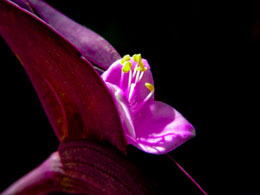If you have not seen a wandering Jew plant, then you have missed out on something. Read this article to know some interesting facts about this plant.

The highly admired plant Wandering Jew is a native of Brazilian and Mexican tropical rainforests, and is extremely beautiful and can be easily grown. This plant resembles spiderworts in many ways, like its pointed leaves and stalkless and trailing stem. The leaves have a unique feature which makes them different from a standard green leaf. They are shiny and two inches long, and their upper surface is painted with silver stripes and purple on the other side. The leaves also have variations in stripe color, like pink, cream, and purple.
Wandering Jew is a character from a 1300's Christian folklore who was cursed to walk the Earth till the second coming, because he supposedly taunted Jesus Christ on the way to the crucifixion. The plant has been named after this eternal wanderer because it is tough and lives a long time, and unlike other creepers that climb up, it crawls wanders away from where it is originally planted.
Common Varieties
Features
Tradescantia fluminensis
Oval, dark green leaves with pointed tips that are shiny, smooth, and slightly fleshy
Tradescantia pallida
Pointed green leaves, fringed with red or purple
Tradescantia zebrina
Attractive zebra-patterned leaves, with upper surface showing purple new growth and green older growth parallel to each other
How to Care for Wandering Jews
The Wandering Jew is the most adorable indoor plant because of its ease to care. The plant requires indirect and bright light, as the color of the leaves fades in dim light. The soil should be kept moist, but do not add water directly in the crown because it might rot your plant. Keep a check that the soil does not become very dry though. Add mild liquid fertilizer to the plant every month. Provide average amount of humidity and warm temperature. If the plant is in a hanging basket, mist it regularly. Keep pruning the ends of the stem frequently, as this will help the stem to grow more branches and give a heavy look to the plant.
If pruning is not done, the stems will grow spindly, so remove the leggy stems. Also, you need to protect the plant from aphids and spider mites which attack the stem. Immediately remove the affected leaves and wash the plant with water. If you want to propagate the plant, cut a three-inch long stem, remove the leaves from the bottom, and dip it into rooting hormone powder and plant it in a pot. It will take a few months for the roots to develop. Here are some facts about this plant that you must know before you have one in your house.
Facts
Scientific Name
Tradescantia zebrina
Common Name
Wandering Jew, Inch Plant
Light Requirement
Bright to filtered light
Temperature
Between 60ºF to 75ºF
Water Requirement
Drench
Humidity
Average
Propagation
Layering and stem cuttings
Decorative Use
Hanging basket and on table
Availability
Year-round
Few Interesting Facts
- Their cousins are Rhoeo and other spiderworts.
- They are the members of Commelinaceae (spiderwort) family.
- The species name zebrina is derived from Portuguese meaning zebra, because of its striped pattern.
- Their color changes like a chameleon; leaves appear green in low light and purple when exposed to high light.
- It helps in reducing air-pollution.
This plant is the least demanding and very easy to grow. You can mix the varieties of this plant in the same pot to give it an entirely different look. It not only adds to your collection of plants, but also enhances the beauty of your house.






 The highly admired plant Wandering Jew is a native of Brazilian and Mexican tropical rainforests, and is extremely beautiful and can be easily grown. This plant resembles spiderworts in many ways, like its pointed leaves and stalkless and trailing stem. The leaves have a unique feature which makes them different from a standard green leaf. They are shiny and two inches long, and their upper surface is painted with silver stripes and purple on the other side. The leaves also have variations in stripe color, like pink, cream, and purple.
The highly admired plant Wandering Jew is a native of Brazilian and Mexican tropical rainforests, and is extremely beautiful and can be easily grown. This plant resembles spiderworts in many ways, like its pointed leaves and stalkless and trailing stem. The leaves have a unique feature which makes them different from a standard green leaf. They are shiny and two inches long, and their upper surface is painted with silver stripes and purple on the other side. The leaves also have variations in stripe color, like pink, cream, and purple.